Drivers around the United States are complaining of potholes on the roads. In fact, there is a serious pothole problem in America. The AAA released their recent study report – which reveals that potholes cost the Americans drivers $3 billion a year. A pothole can damage your car other than making your ride bumpy. The suspension system of your car gets messed up when you drive over a pothole. On the other hand, potholes can bend the wheels of your car and puncture them in the process.
Pothole-related repair costs can vary depending on the type of damage to your car. RepairPal is a good online tool to get an estimate on specific types of car repairs. Your location and other variables can affect the cost of repairs. In fact, the average repair cost will be around $300. You should contact a mobile mechanic Houston for assistance in this regard.
$300 is a lot of money. For that amount of money, you can easily take your family to Disneyland. It is a pity that we have to deal with potholes on our road network since the government is responsible for providing its people with safe roads and bridges for travel. Potholes would make most of you mad. In fact, you should be writing to Congress and telling them to fund the road development projects in your area.
There is at least one pothole in your daily commute. In fact, most people are complaining about it. Then there is another one and another one – which go on and on. These potholes are quite annoying and will damage your car upon impact. Public works associations have been repairing a lot of these potholes lately with the assistance of the public. Most potholes need urgent repairs today. You should pressurize the city councils to get the work done immediately.
The city is not responsible for the damage caused to your car due to potholes on the roads – unless the work crews were negligent. Since the city doesn’t insure the streets, they are not responsible for repairing damaged cars under the prevailing law. The American Automobile Association conducted a survey in 2016 and found out that potholes on the road networks have caused damages to the vehicles contributing to more than $3 billion per year for the last five years.
Many public works associations have promised to repair potholes on roads within 48 hours of receiving a complaint from a resident. If you run into a pothole while driving, here are some tips to avoid them – courtesy of State Farm Insurance.
- Drive on familiar roads. In fact, you can easily avoid potholes when you drive on roads that are familiar to you.
- Make sure that you travel on roads that are well-lit. You will be able to see the surface of the road while driving in the night when the road is well-lit.
- Slow down and you can easily spot a pothole and avoid it while driving.
- Avoid tailgating. It is important that you give yourself time to be able to see the road conditions ahead when driving behind another vehicle.
- Brake before the impact. When you aggressively apply brakes, there is a greater load on the tires, wheels, and suspension system of the car. This can cause more damage to your car. That is why it is important that you brake at a distance before the impact.
AAA provided the following tips:
- Check your tires for proper inflation at regular intervals. The tires are the main cushion between the wheels and suspension on your car and the pothole. Hence, it is important to check the inflation on a regular basis.
- Prevent swerving. Use your rear-view mirror before trying to avoid a pothole. It is important to prevent the risk of a collision.
- Listen for strange vibrations from the car. Pothole impacts can bend or break the suspension components in your car. It may also damage tires and wheels and dislodge wheel weights.
- Check the wheel alignment. A pothole can affect the steering of the car. It may knock the wheels of the car out of alignment in the process.
How Do You Prevent Damages To The Car From Potholes?
Driving is all about coping with potholes and traveling safely. In fact, damaged wheels and tires will leave motorists stranded at the side of the road – thereby leaving their wallets empty.
The new Ford, Lincoln, and Mercury vehicles go through a stringent testing process in order to prevent damages caused by chuckholes. Ford uses several proving grounds in order to validate its vehicle designs such as Romeo, Mich., and Dearborn, Mich. These grounds are filled with different types of torture devices to test and improve the durability of the vehicle.
The engineers at Ford design spare parts up-front to deal with these potholes. They balance these parts for numerous other custom driving conditions. The engineers will tune shock rebound rates in order to keep the wheel and tire suspended to glide over the pothole. This will prevent the tire from dropping into the pothole and impacting the edge of the tire and wheel.
Ford Motor Company Offers Drivers Several Tips To Prevent Damage To The Vehicles From Potholes:
Keep the tire pressure constant at the manufacturer’s recommendation. This will help protect the wheels and tires from being damaged due to the impact of the pothole. Don’t swerve to avoid a pothole. It creates a situation where the front wheel and tire hit the edge of the hole at an obtuse angle. This can do more harm than hitting the pothole squarely. If you are safe, don’t brake as soon as you see a pothole. Instant braking will compress the car’s front suspension and force the wheel and tire down the pothole without gliding over it.
In fact, even if you drive very carefully, there is a chance of having a flat tire on the highway. Drive slow to the closest safe area out of traffic. Even though this can damage the flat tire – your safety is more important.
If you suspect your car has been damaged or feel a sudden vibration, reduce your speed immediately. Drive slowly until you can safely pull off the road. Inspect your tires for damage. If the tire is flat, replace it with the spare wheel. If you can’t find a cause, get your car towed to the nearest repair shop and have a mobile mechanic Houston inspect your car.

























